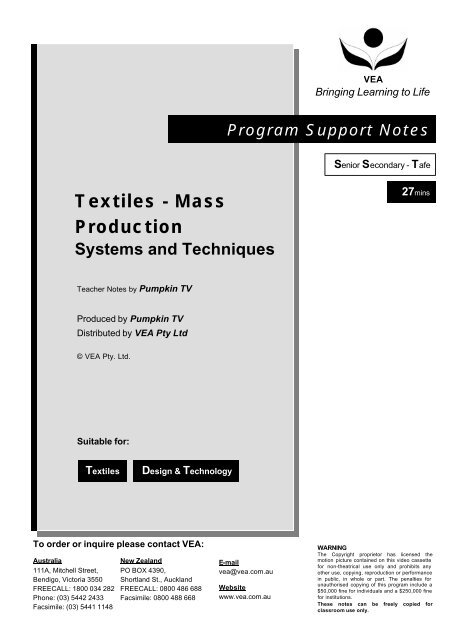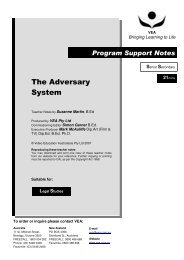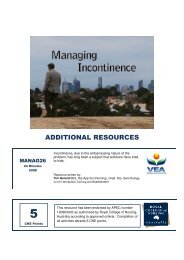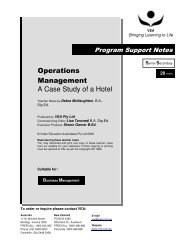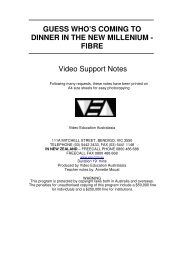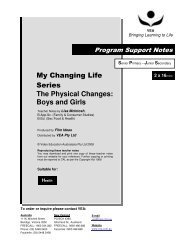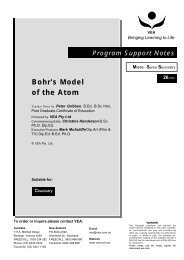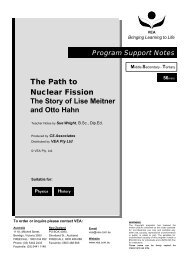Textiles - Mass Production Systems and Techniques - VEA
Textiles - Mass Production Systems and Techniques - VEA
Textiles - Mass Production Systems and Techniques - VEA
Create successful ePaper yourself
Turn your PDF publications into a flip-book with our unique Google optimized e-Paper software.
<strong>Textiles</strong> - <strong>Mass</strong><br />
<strong>Production</strong><br />
<strong>Systems</strong> <strong>and</strong> <strong>Techniques</strong><br />
Australia<br />
111A, Mitchell Street,<br />
Bendigo, Victoria 3550<br />
FREECALL: 1800 034 282<br />
Phone: (03) 5442 2433<br />
Facsimile: (03) 5441 1148<br />
Teacher Notes by Pumpkin TV<br />
Produced by Pumpkin TV<br />
Distributed by <strong>VEA</strong> Pty Ltd<br />
© <strong>VEA</strong> Pty. Ltd.<br />
Suitable for:<br />
<strong>Textiles</strong> Design & Technology<br />
To order or inquire please contact <strong>VEA</strong>:<br />
New Zeal<strong>and</strong><br />
PO BOX 4390,<br />
Shortl<strong>and</strong> St., Auckl<strong>and</strong><br />
FREECALL: 0800 486 688<br />
Facsimile: 0800 488 668<br />
E-mail<br />
vea@vea.com.au<br />
Website<br />
www.vea.com.au<br />
<strong>VEA</strong><br />
Bringing Learning to Life<br />
Program Support Notes<br />
Senior Secondary - Tafe<br />
27mins<br />
WARNING<br />
The Copyright proprietor has licensed the<br />
motion picture contained on this video cassette<br />
for non-theatrical use only <strong>and</strong> prohibits any<br />
other use, copying, reproduction or performance<br />
in public, in whole or part. The penalties for<br />
unauthorised copying of this program include a<br />
$50,000 fine for individuals <strong>and</strong> a $250,000 fine<br />
for institutions.<br />
These notes can be freely copied for<br />
classroom use only.
For Teachers:<br />
Introduction<br />
<strong>Textiles</strong> - <strong>Mass</strong> <strong>Production</strong> - <strong>Systems</strong> <strong>and</strong> <strong>Techniques</strong><br />
Showcasing the latest industrial techniques, this program offers students a fantastic insight into textile<br />
manufacturing processes. We look at: Commercial production methods <strong>and</strong> systems, including job,<br />
batch, quantity/mass production <strong>and</strong> JIT; Pattern laying - both h<strong>and</strong> <strong>and</strong> digitised; Cutting/marking up;<br />
Assembly; CAD/CAM is in quality control <strong>and</strong> management information systems; Globalisation of the<br />
textile industry - including overseas factory visits; Case studies including production of baseball hats,<br />
sky-diving suits, airline seat covers, quilted covers, sweatshirts <strong>and</strong> more.<br />
Other Relevant Programs Available from <strong>VEA</strong><br />
<strong>Textiles</strong> – Industrial Printing <strong>and</strong> Dyeing<br />
Testing <strong>Textiles</strong><br />
Materials for Design – Felt<br />
Materials for Design – Resin Jewellery<br />
Inspiration for Design<br />
Please visit our website for many more relevant programs www.vea.com.au<br />
<strong>VEA</strong> – Bringing Learning to Life<br />
- 2 -
<strong>Textiles</strong> - <strong>Mass</strong> <strong>Production</strong> - <strong>Systems</strong> <strong>and</strong> <strong>Techniques</strong><br />
Commercial <strong>Production</strong> Methods<br />
Individual or job production<br />
Also referred to as “one off” production, jobbie, jobbing or making through. This is a traditional<br />
method of production where one operator or team assembles the whole of a textile product. Each<br />
product is a one-off, unique item, only made once in response to a brief or a specific client’s request.<br />
Batch production<br />
Manufacturers like Precision Stitching use job production for<br />
their sky diving suits, as does bespoke tailor Timothy Everest.<br />
This system enables them to produce a “tailor made” garment<br />
designed to fit the individual client.<br />
For example the particular characteristics of a person can be<br />
considered in the cutting <strong>and</strong> sewing of such a garment, eg a<br />
rounded back, extra long legs, etc.<br />
It requires highly skilled operators, involves a high throughput<br />
time, (i.e. takes a long time to make), is labour intensive,<br />
<strong>and</strong> requires versatile machinery that can be adapted to<br />
different tasks.<br />
The end product is usually of high quality <strong>and</strong> high value.<br />
This system of production is used for the production of a specified quantity of identical products, i.e.<br />
not one-off <strong>and</strong> not for large quantities as in mass or volume production. <strong>Production</strong> can either be for<br />
stock (to retain by the manufacturer in case an order is placed for the item, or for an order.<br />
For batch production<br />
Batch <strong>Production</strong> is flexible <strong>and</strong> can be used to produce batches of<br />
similar products with only a small change to the tooling. Batches can<br />
be repeated as many times as needed with products being cheaper due<br />
to lower production costs. It also enables a variety of styles to be made.<br />
Against batch production<br />
It can lead to lost time during the change in production of one textile<br />
product to another as equipment needs to be re-set after each production<br />
run. The increased number of textile products sometimes increases stock<br />
levels. Staff can sometimes specialise in one aspect of production <strong>and</strong><br />
work may therefore become repetitive <strong>and</strong> boring.<br />
- 3 -
<strong>Textiles</strong> - <strong>Mass</strong> <strong>Production</strong> - <strong>Systems</strong> <strong>and</strong> <strong>Techniques</strong><br />
There are different types of batch production<br />
Progressive bundle system. This system embraces some features <strong>and</strong> advantages of the straight line<br />
system <strong>and</strong> the section/cell system. Workers are organised into sections according to the basic<br />
functions that make up a textile product, eg sleeves, pockets, small parts <strong>and</strong> joining seams. Eg<br />
Sweatshirts made at Price <strong>and</strong> Buckl<strong>and</strong>.<br />
Section system. This system may be used for producing batches of textile items. Unlike the<br />
progressive bundle system, the section system is used by factories that deal with frequent style changes<br />
<strong>and</strong> small numbers of items per product type. Sections are located close together. Each worker<br />
specialises in a section of the assembly line constructing a garment component, which is then<br />
transferred to the next stage in the line.<br />
Pros – it allows for easy product changes<br />
Cons – requires a lot of floor space <strong>and</strong> longer through-put time.<br />
<strong>Mass</strong>/volume or quantity production<br />
This is used for very large orders of identical products for a relatively low cost. Machines are<br />
continuously in use for the same style. The machine operatives will carry out the same operation daily,<br />
eg a machinist may continuously join side seams on a style whilst another may just button hole.<br />
It can be divided into two categories – repetitive flow production or continual flow production<br />
Repetitive flow/ flow line production: <strong>Production</strong> is usually broken down into sub assemblies of<br />
smaller components. This form of mass production can be labour intensive or completely automated<br />
depending on the product. This type of production is often outsourced to the Far East <strong>and</strong> countries like<br />
Indonesia <strong>and</strong> Cambodia. The baseball cap manufacturer in Indonesia used in the programme uses this<br />
type of production<br />
Continual flow: This is the uninterrupted production of a textile product along an assembly line until<br />
it is complete. This method involves production for 24 hours a day to reduce costs because it is<br />
expensive to shut down <strong>and</strong> re-start. Only a small work force is needed to maintain the process<br />
Types of commercial manufacturing systems<br />
Cell<br />
This is when a number of workstations are grouped to produce a single component<br />
In-line assembly<br />
This system is used to mass product many every day items especially cars. Many in-line assembly<br />
systems are fully automated <strong>and</strong> only require people to ensure continual flow<br />
Off the peg manufacture<br />
This refers to textile items which are cheaper because they are made to fit st<strong>and</strong>ard average sizes, not<br />
the exact measurements of a particular individual. When making off the peg clothes the st<strong>and</strong>ard size<br />
template can be used for a production run. This allows a batch of items to be made at one time,<br />
spreading costs <strong>and</strong> making unit items less expensive. The programme shows sweatshirts being made<br />
in this way.<br />
- 4 -
JIT<br />
<strong>Textiles</strong> - <strong>Mass</strong> <strong>Production</strong> - <strong>Systems</strong> <strong>and</strong> <strong>Techniques</strong><br />
Just in Time is a system developed to ensure materials <strong>and</strong> goods arrive as they are needed, i.e.<br />
garments will arrive at the shop just before they need to go onto the shop floor; raw materials will<br />
arrive at the factory just before they are needed for that stage in the production. This system therefore<br />
saves a company time <strong>and</strong> money in tied up stock <strong>and</strong> storage space.<br />
Retailers like Top Shop <strong>and</strong> Zara use JIT to enable them to change their fashion lines quickly to<br />
maintain their competitive edge. JIT enables them to reduce their time to market <strong>and</strong> cut the amount of<br />
stock held in shops. Manufacturers like Precision Stitching, use JIT systems to reduce the amount of<br />
stock they hold <strong>and</strong> the amount of time stock is held in storage so reducing costs. This enables<br />
companies produce shorter runs in different fabrics. This requires re-negotiation with suppliers to<br />
ensure reliable delivery of last minute orders <strong>and</strong> to maintain competitive prices, despite reductions in<br />
bulk orders.<br />
Logistics<br />
This means that the production of products relies upon the availability of materials <strong>and</strong> components<br />
when required. The case study on John Smedley, which can be found under “ICT Case Study”, is a<br />
good example. It shows how the effective <strong>and</strong> integrated use of ICT is particularly important in<br />
managing the “logistics” of a “forward order business”.<br />
Preparation <strong>and</strong> marking of fabric<br />
Hot drill<br />
Definition<br />
A vertical hot probe that makes small holes in fabric layers.<br />
Use<br />
Accurately piercing multiple layers of cut pieces to mark an<br />
important place, eg where a dart needs to be sewn.<br />
Dye markers<br />
Definition<br />
A hole is marked by a colour dye. Sometimes a fluorescent dye may be used which can only be seen<br />
under an ultra-violet lamp.<br />
Use<br />
Particularly useful for marking pocket positions <strong>and</strong> dart lengths.<br />
Hot notcher<br />
Definition<br />
Heat is used to mark the fabric in the correct place.<br />
Use<br />
This method is used for marking the edge of the fabric where notches may be seen on pattern pieces.<br />
Because of the heat involved it is only used on knitted or natural fibres as the edges of synthetic fabrics<br />
may fuse together.<br />
Thread markers<br />
Definition<br />
A tacking thread is stitched through the layers of fabric <strong>and</strong> is cut between each layer. A fluorescent<br />
thread may be used to enhance visibility.<br />
Use<br />
This method is used when a drill may damage the fabric.<br />
- 5 -
Sewing machines<br />
<strong>Textiles</strong> - <strong>Mass</strong> <strong>Production</strong> - <strong>Systems</strong> <strong>and</strong> <strong>Techniques</strong><br />
Single needle sewing machine<br />
Definition<br />
A single needle over lock has three threads. It sews one line along a cut edge that is trimmed <strong>and</strong><br />
secured by the machine.<br />
Use<br />
It is used for close knit or woven fabrics <strong>and</strong> for edging single pieces as opposed to joining fabrics<br />
together.<br />
Twin needle sewing machine<br />
Definition<br />
A twin needle machine has a second needle so that two rows are<br />
sewn in parallel.<br />
Use<br />
Because it creates a stronger seam it is necessary for more loosely<br />
constructed fabrics where there is likely to be pressure along on the<br />
joined seam when worn<br />
Overlocker<br />
Definition<br />
An overlock machine has no bobbin; instead cones of thread are<br />
used <strong>and</strong> threaded from the top. It creates a line (or lines) of<br />
stitching along the edge of one or more fabrics to edge or join. It<br />
incorporates a blade that trims the fabric close to the sewing. Top<br />
<strong>and</strong> bottom threads are looped together ‘over’ the cut edge <strong>and</strong><br />
‘locked’ by the thread(s) in the sewn line(s).<br />
Use<br />
Particularly useful on knitted fabrics.<br />
Electronic or computer-controlled sewing machines<br />
They produce a vast range of decorative stitches, text as well as the basic stitches. The programme<br />
shows them being used to embroider the sweatshirts. They are also used to embroider the base ball<br />
caps. Information can be programmed in by the user <strong>and</strong> held in the memory which is supported by a<br />
battery for when the machine is not connected to the mains. The machine will set the stitch length <strong>and</strong><br />
its width. Models vary with some allowing the user to design their own stitches <strong>and</strong> some supplying<br />
computer disks or cartridges to extend the range of stitching<br />
- 6 -
<strong>Textiles</strong> - <strong>Mass</strong> <strong>Production</strong> - <strong>Systems</strong> <strong>and</strong> <strong>Techniques</strong><br />
<strong>Textiles</strong> Cutting Tools<br />
Straight blade knife<br />
Definition<br />
An electric cutting knife with a straight vertically<br />
oscillating blade. It is steered by h<strong>and</strong> <strong>and</strong> is used<br />
round multiple layers of fabric that have been<br />
marked out in preparation for cutting.<br />
Use<br />
Most types of smooth fabric that is unlikely to<br />
snag. It will cut corners <strong>and</strong> curves accurately to a<br />
depth of 30mm. Small to medium sized orders both<br />
coarse <strong>and</strong> accurate cutting. Disadvantage =<br />
quality is reliant on the skill of the cutter.<br />
Automatic/ computer controlled cutters<br />
Definition<br />
These cutters are fully automated <strong>and</strong> can be used with a<br />
choice of cutting forms to suit any fabric type <strong>and</strong> depth,<br />
for example vertical blades, laser blades <strong>and</strong> high<br />
pressure water jets.<br />
Use<br />
Because the initial outlay <strong>and</strong> installation costs for the equipment<br />
are high, they are best used for deeper lays <strong>and</strong> high volume<br />
orders. However once set up the process is fully automated so is<br />
economical, accurate <strong>and</strong> fast.<br />
Round blade knife<br />
Definition<br />
This is similar to a straight knife, but it has a circular blade<br />
of about six inches diameter.<br />
Use<br />
The round blade knife is suitable for coarse gauge knitted<br />
fabric that might get trapped by a vertical straight blade.<br />
Like the straight blade knife, it is used where the lays are<br />
shallow <strong>and</strong> for small to medium sized orders.<br />
- 7 -
<strong>Textiles</strong> - <strong>Mass</strong> <strong>Production</strong> - <strong>Systems</strong> <strong>and</strong> <strong>Techniques</strong><br />
Die cutter<br />
Definition<br />
It works much like a pastry cutter. Each die is the same shape<br />
<strong>and</strong> size as the required pattern pieces. These are stamped out to<br />
create identical <strong>and</strong> exact shapes.<br />
Use<br />
Good for stable flat fabrics that need to be cut accurately <strong>and</strong><br />
where very fine tolerances are needed. Also used for materials<br />
that are difficult to cut without extreme pressure, eg leather,<br />
laminates.<br />
B<strong>and</strong> knives<br />
B<strong>and</strong> knives are suitable for precision cutting to a depth of 300mm <strong>and</strong> are used with deeper lays. They<br />
will cut corners, tight curves <strong>and</strong> pointed incisions precisely. Because the equipment is expensive, it is<br />
best used with high volume orders which can yield significant economies of scale.<br />
The disadvantage of this method is that the production method is slow <strong>and</strong> because the layers of fabric<br />
are stapled together to prevent slippage, it is too reliant upon the skill of the cutter to prevent mistakes.<br />
Quality Assurance <strong>and</strong> Quality Control<br />
Quality assurance<br />
Carefully defining the product’s qualities (aka the specification), creating management <strong>and</strong> production<br />
systems to make sure these qualities are assured at every stage of design, development <strong>and</strong> production.<br />
Quality control<br />
The specific checks <strong>and</strong> tests carried out at various stages of production to ensure that products meet<br />
an agreed specification. Each of the checks is called a control point.<br />
Quality control at Price-Buckl<strong>and</strong><br />
Price Buckl<strong>and</strong> make embroidered sweatshirts, fleeces <strong>and</strong> jumpers for schools, clubs <strong>and</strong> companies.<br />
Although they now import some blank garments, the majority are made up <strong>and</strong> embroidered at the<br />
factory. If faults are not detected until the garment is finished it may well have to be scrapped – an<br />
expensive option. The quality control system is designed to pick up errors as quickly as possible:<br />
Fabric 1<br />
A sample of every batch of fabric is checked for colour in a light-box. It<br />
is also checked for weave/knit quality. Every few months samples of<br />
fabric will also be sent to a testing house where they are checked for<br />
pilling (bobbling), dye fastness <strong>and</strong> wear.<br />
Assembly<br />
Fabric 2<br />
Each roll of fabric is checked for marks <strong>and</strong> weave/knit<br />
quality as it is laid out by the cutter.<br />
During the assembly phase each machinist checks her own work for marks, <strong>and</strong> construction (sewing)<br />
quality. Any excess threads are removed.<br />
- 8 -
Garment check 1<br />
<strong>Textiles</strong> - <strong>Mass</strong> <strong>Production</strong> - <strong>Systems</strong> <strong>and</strong> <strong>Techniques</strong><br />
At the end of the assembly phase each garment is pressed <strong>and</strong><br />
checked again for marks, excess bits of thread <strong>and</strong> construction.<br />
Garment check 2<br />
Price Buckl<strong>and</strong> Quality Control Sheet<br />
Embroidery<br />
The embroidery machines are designed to stop automatically, if a<br />
thread breaks, misses a stitch, or becomes tangled. The operators<br />
also check the embroidered areas themselves, removing any<br />
excess bits of thread by h<strong>and</strong>.<br />
Final control<br />
Approximately 1 in 20 garments are given a full quality control<br />
check which includes: checking for sizing, number of stitches per<br />
inch, labelling <strong>and</strong> marks.<br />
All garments are pressed again <strong>and</strong> given a final visual inspection before being packed up ready for<br />
sending out to the customer. 1 in 20 garments are given a full quality control inspection.<br />
Errors are few <strong>and</strong> far between but when they are found the source is traced <strong>and</strong> the problem rectified.<br />
- 9 -
<strong>Textiles</strong> - <strong>Mass</strong> <strong>Production</strong> - <strong>Systems</strong> <strong>and</strong> <strong>Techniques</strong><br />
Globalisation <strong>and</strong> Workers' Rights<br />
As a supplier of goods to American Universities, the PT DADA factory featured in the video clip was<br />
the subject of a report into working conditions by the US Workers Rights Consortium. The preliminary<br />
report, published in March 2002 highlighted a number of areas of concern:<br />
1. Punishing <strong>and</strong> Deterring Sick Leave<br />
“There is substantial evidence that supervisors impose abusive punishments on workers who have<br />
taken sick leave, <strong>and</strong> wrongfully deter workers who wish to take sick leave. For example, the<br />
company punishes <strong>and</strong> deters sick leave by frequently requiring workers, on the day they return<br />
from sick leave, to st<strong>and</strong> erect without moving for periods of one hour to entire workdays. The<br />
punishment is designed to humiliate workers, <strong>and</strong> inflicts physical hardship on convalescing<br />
workers.”<br />
2. Danger of Severe Heat Stress:<br />
“There is substantial evidence that several elements of the working environment pose significant<br />
risks of illness or even fatality as a result of heat-related disorders, including dehydration,<br />
exhaustion, fainting, heat cramps, salt deficiency, heat exhaustion, <strong>and</strong> heat stroke. Many workers<br />
at PT Dada experience dizziness, exhaustion, dehydration, <strong>and</strong> fainting. The factory is located, of<br />
course, in a tropical climate, with extended periods of severe heat <strong>and</strong> intense humidity. The<br />
factory has no air-conditioning <strong>and</strong> only a few small fans (some malfunctioning) in its very large<br />
production areas. Ventilation in the factory is poor <strong>and</strong> air circulation is weak. Even the factory<br />
clinic, where many workers seek to recuperate during the workday, has no air-conditioning. Many<br />
workers are required to st<strong>and</strong> in one position, doing repetitive tasks, throughout the workday. The<br />
vast majority of PT Dada workers are very young women of slight stature. The majority of women<br />
workers in Indonesia suffer some degree of iron deficiency anaemia <strong>and</strong> are, thus, susceptible to<br />
rapid fatigue. PT Dada workers take their drinking water from large plastic bins containing hot<br />
water provided by an outside contractor. The water is sometimes discoloured, malodorous, <strong>and</strong><br />
distasteful. (Other, comparable factories in Indonesia provide cool, bottled water). Taken together,<br />
these conditions create high risks of severe heat stress <strong>and</strong> heat-related disorders.”<br />
3. Homework:<br />
“There is substantial evidence that PT Dada supervisors often require workers to continue their<br />
work at home, after working their regular <strong>and</strong> overtime hours in the factory. The wage for<br />
homework is calculated by piece-rates which are far too low to enable workers to earn the<br />
statutory minimum wage or to earn PT Dada’s hourly wage rates for regular work, let alone<br />
statutory <strong>and</strong> company rates for overtime work. Record-keeping of homework is inadequate, <strong>and</strong><br />
the company often pays for homework through transactions that do not appear on pay stubs.<br />
(Managers testified that they are unaware that PT Dada workers do homework.)”<br />
4. Freedom of Association:<br />
“There is substantial evidence that PT Dada has engaged in many serious acts of interference,<br />
intimidation, <strong>and</strong> retaliation against workers seeking to organise those unions that are not favoured<br />
by managers. These acts include interrogation, demotion, suspension, <strong>and</strong> threats of job loss <strong>and</strong><br />
plant closing. One of the most severe acts of retaliation was the company’s “solitary confinement”<br />
of a union supporter over a two week period in late 2001. The worker was required to spend her<br />
workdays—ranging from eight to twelve hours—working alone in a small, windowless,<br />
unventilated storage space. She was placed under guard, <strong>and</strong> permitted to obtain food <strong>and</strong> water<br />
only erratically <strong>and</strong>, on some days, not at all."<br />
A full copy of the report can be downloaded from: http://www.workersrights.org/freports.asp<br />
Since the publication of the report <strong>and</strong> after pressure from consumers a number of improvements have<br />
been made.<br />
Workers now have improved first aid, medical support <strong>and</strong><br />
access to cool drinking water. With weekly meetings, workermanagement<br />
relations have also begun to improve.<br />
- 10 -
Globalisation Links<br />
<strong>Textiles</strong> - <strong>Mass</strong> <strong>Production</strong> - <strong>Systems</strong> <strong>and</strong> <strong>Techniques</strong><br />
• www.oxfam.org.uk/coolplanet<br />
Oxfam is one of the world's leading charities <strong>and</strong> helps bring awareness of global citizenship to<br />
teachers <strong>and</strong> students.<br />
• The Cool Planet website is primarily intended for teachers <strong>and</strong> their students. It aims to bring the<br />
global dimension to the classroom, using the concept of Global Citizenship.<br />
• Oxfam has also brought together a selection of resources about sport, sportswear <strong>and</strong> child labour<br />
which can be found at: Sport Relief 2004,<br />
• www.labourbehindthelabel.org<br />
Labour Behind the Label is a membership organisation which brings together pressure groups,<br />
trade unions <strong>and</strong> individuals in support of garment workers' efforts to improve their working<br />
conditions <strong>and</strong> wages. It draws attention to the plight of garment workers everywhere, including<br />
Britain, <strong>and</strong> works to facilitate information exchange <strong>and</strong> international solidarity between workers<br />
<strong>and</strong> consumers.<br />
It is the UK platform of the Europe-wide Clean Clothes Campaign. The site provides case studies<br />
on companies like Gap, Sportswear as well as providing online resources <strong>and</strong> links to other useful<br />
sites.<br />
LBL also produce a free booklet aimed at young people called ‘Exposed’, which explores ethical<br />
issues within the global fashion industry. Case studies used include the Nike trainer <strong>and</strong> football<br />
producers in Pakistan. The electronic version can be found on www.jusbiz.org<br />
• www.cleanclothes.org<br />
Specifically aimed at young people, the Clean Clothes Campaign works to improve the working<br />
conditions in the global garment industry.<br />
• www.caa.org.au<br />
Australia's leading agency working with communities around the world for solutions to poverty<br />
<strong>and</strong> social injustice.<br />
• www.ilo.org<br />
The International Labour Organisation is the UN specialised agency which seeks the promotion of<br />
social justice <strong>and</strong> internationally recognised human <strong>and</strong> labour rights.<br />
• www.globalexchange.org<br />
A US based international human rights organisation dedicating to promoting environmental, social<br />
<strong>and</strong> political justice. The website contains sections on Fair Trade <strong>and</strong> Sweatshops.<br />
- 11 -
Glossary<br />
<strong>Textiles</strong> - <strong>Mass</strong> <strong>Production</strong> - <strong>Systems</strong> <strong>and</strong> <strong>Techniques</strong><br />
Batch system<br />
A type of industrial production method where a specific amount of identical items are made at the<br />
same time.<br />
Bespoke production<br />
A type of production method where only one textile product is made. It is individually tailored to fit an<br />
individual's body measurements. The customer selects material <strong>and</strong> design <strong>and</strong> personal details are<br />
added, for example a longer length of sleeve. For example the tailor made suits made by bespoke tailor<br />
Timothy Everest.<br />
Dye/die cutter<br />
It works much like a pastry cutter with each die being the same shape ad size as the required pattern<br />
pieces. These are stamped out to create identical <strong>and</strong> exact shapes. A press or die cutting is good for<br />
stable flat fabrics that need to be cut extremely accurately <strong>and</strong> for products where very fine tolerances<br />
are needed. It is also used for materials that are difficult to cut without extreme pressure, for example<br />
leather, coated <strong>and</strong> laminated materials. It is good for mass produced items requiring the same patterns<br />
over a long period of time.<br />
Hot drill marker<br />
The hot drill is a vertical hot probe. It makes small visible holes in the fabric layers. It is used to<br />
accurately pierce a multiple layer of cut pieces to mark an important place, for example where a dart<br />
needs to be sewn. It can be used to make the holes more durable.<br />
JIT manufacturing system<br />
A type of industrial production method where all parts of a product arrive at the manufacturing point<br />
just in time for production to reduce costs.<br />
Lay plan<br />
Process to show the most efficient use of pattern pieces on a piece of fabric prior to cutting. The<br />
programme shows this being done electronically on a white board for a kayaking vest.<br />
Progressive bundle system<br />
A method of industrial production used for larger fixed amounts of identical products. The programme<br />
shows this system being used in the production of sweatshirts.<br />
Quality control<br />
Tests <strong>and</strong> inspections are carried out to ensure that the product meets the specification criteria.<br />
Seal<br />
A sample of a product, made to a correct <strong>and</strong> agreed specification. This is sealed by the customer or<br />
test house <strong>and</strong> thereafter used in conjunction with an agreed written specification as the st<strong>and</strong>ard to<br />
which bulk production will be manufactured <strong>and</strong> used in any subsequent inspection or dispute.<br />
Sourcing fabrics<br />
The process of researching <strong>and</strong> finding the appropriate type of material for a product, <strong>and</strong> identifying a<br />
reliable <strong>and</strong> suitable supplier for that material.<br />
St<strong>and</strong>ard minutes<br />
The st<strong>and</strong>ard time allowed to perform an operation, including rest allowance.<br />
Tolerance<br />
The allowed variation in size or weight etc of a product.<br />
- 12 -
<strong>Textiles</strong> - <strong>Mass</strong> <strong>Production</strong> - <strong>Systems</strong> <strong>and</strong> <strong>Techniques</strong><br />
Student Worksheet:<br />
After Viewing the Program<br />
Section 1: Patterns, Laying <strong>and</strong> Cutting<br />
1. Describe how a computer can be used to create pattern pieces, produce a lay plan <strong>and</strong> cut the<br />
fabric.<br />
2. Explain the advantages of using a computer-controlled system to generate pattern pieces rather<br />
than using traditional cardboard or paper pattern pieces.<br />
3. Describe how fifty layers of fabric are laid out <strong>and</strong> cut ready for volume production.<br />
4. The pictures below show equipment used when cutting fabric. Describe the use of each one.<br />
a) Straight Bladed Knife<br />
______________________________________________________<br />
______________________________________________________<br />
______________________________________________________<br />
______________________________________________________<br />
c) Dye Cutters<br />
______________________________________________________<br />
______________________________________________________<br />
______________________________________________________<br />
______________________________________________________<br />
- 13 -<br />
b) Round Bladed Rotary Cutter<br />
______________________________________________________<br />
______________________________________________________<br />
______________________________________________________<br />
______________________________________________________<br />
_________________________________________________________<br />
_________________________________________________________<br />
_________________________________________________________<br />
_________________________________________________________<br />
d) Hot Drill
Section 2: Assembly<br />
<strong>Textiles</strong> - <strong>Mass</strong> <strong>Production</strong> - <strong>Systems</strong> <strong>and</strong> <strong>Techniques</strong><br />
5. The pictures below show the four main types of sewing machines used when assembling textiles<br />
products. Describe the use of each one.<br />
a) Single Needle Sewing Machine<br />
__________________________________________________________________<br />
__________________________________________________________________<br />
__________________________________________________________________<br />
__________________________________________________________________________________<br />
__________________________________________________________________<br />
__________________________________________________________________<br />
__________________________________________________________________<br />
- 14 -<br />
b) Overlock Machine<br />
__________________________________________________________________________________<br />
c) Twin Needle Machine<br />
___________________________________________________________________<br />
___________________________________________________________________<br />
___________________________________________________________________<br />
___________________________________________________________________<br />
__________________________________________________________________<br />
__________________________________________________________________<br />
__________________________________________________________________<br />
d) Button Based Machine<br />
__________________________________________________________________________________<br />
6. List three other specialist machines a Textile Manufacturer may use.<br />
7. Use the st<strong>and</strong>ard flow chart symbols to describe the order of assembly of a sweatshirt made using<br />
the progressive bundle or batch production system. Include quality control checks.<br />
8. Explain the differences between the ‘progressive bundle’ production system <strong>and</strong> ‘job production’.<br />
9. The ‘job production’ system is a more expensive system to use. Explain why some companies still<br />
use this manufacturing system.<br />
10. List three checks that would be made on a completed garment before it is packed <strong>and</strong> dispatched.
<strong>Textiles</strong> - <strong>Mass</strong> <strong>Production</strong> - <strong>Systems</strong> <strong>and</strong> <strong>Techniques</strong><br />
Section 3: Quality Control<br />
11. Some companies buy in ready-made garments to customise with embroidered logos.<br />
List four quality control checks that could be made on a garment when it is delivered to the<br />
company.<br />
12. Describe three quality control checks that should be made on a garment during the manufacturing<br />
process.<br />
Section 4: Control <strong>Systems</strong><br />
13. Some textile manufacturers use bar codes to monitor production. Explain how this is done.<br />
14. Explain how ICT can be used in the administration of a textiles company.<br />
Section 5: Globalisation<br />
15. Explain how ‘consumer power’ has improved the working conditions in factories in Indonesia.<br />
Extension Activities<br />
Additional research will be needed to complete these tasks.<br />
16. Explain the disadvantages of using computer aided design <strong>and</strong> computer aided manufacture in the<br />
textiles industry.<br />
17. Job production <strong>and</strong> batch production are two manufacturing systems. Other manufacturing<br />
systems include repetitive flow production, continual flow, cell production, in-line assembly, just<br />
in time, <strong>and</strong> ‘off the peg’. Research these systems <strong>and</strong> give examples of the products made using<br />
each.<br />
18. Explain the implications to a manufacturer of failing to use quality control systems when<br />
manufacturing textile products.<br />
19. Health <strong>and</strong> safety is an important issue in the manufacturing industry <strong>and</strong> there is legislation in<br />
place to protect employees. Design a leaflet that could be given to employees to inform them<br />
about personal safety, risk assessment <strong>and</strong> the common safety symbols used in the workplace <strong>and</strong><br />
on consumable materials.<br />
20. Textile products have to be labelled to provide the consumer with information about the product.<br />
Research the type of information that needs to be included on labels attached to textile products.<br />
Present your research in the form of a leaflet that could be supplied to textile companies.<br />
21. Explain how the packaging <strong>and</strong> marketing of a product can have a significant impact on the<br />
consumer.<br />
- 15 -


